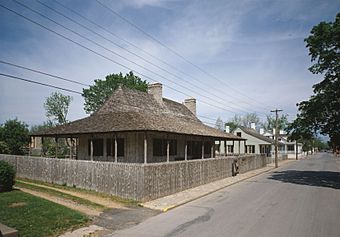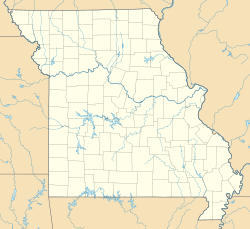Louis Bolduc House facts for kids
|
Louis Bolduc House
|
|
|
U.S. National Historic Landmark District
Contributing Property |
|

Louis Bolduc Historic House
|
|
| Location | 123 S. Main St., Ste. Genevieve, Missouri |
|---|---|
| Built | 1788 |
| Architectural style | French Colonial |
| Part of | Ste. Genevieve Historic District (ID66000892) |
| NRHP reference No. | 69000305 |
Quick facts for kids Significant dates |
|
| Added to NRHP | April 16, 1969 |
| Designated NHL | April 15, 1970 |
| Designated NHLDCP | October 15, 1966 |
The Louis Bolduc House, also known as Maison Bolduc, is a special old house that's now a museum. You can find it at 123 South Main Street in Ste. Geneviève, Missouri. This house is a great example of a building style called poteaux sur solle, which means "posts-on-sill." It's built in the very first European town in what is now Missouri.
This house was the first old building in Ste. Genevieve to be carefully brought back to its original look. It shows us what traditional French Colonial homes looked like in North America in the early 1700s. Because it's so important, it was named a National Historic Landmark in 1970.
Contents
The Story of the Bolduc House
Ste. Genevieve was started in the mid-1700s by French-Canadian settlers. Most of them moved from villages on the east side of the Mississippi River. Because the river kept flooding, especially badly in 1785, they decided to move to a higher spot. This new location was further away from the river.
Building the Bolduc Home
In 1792, Louis Bolduc, a successful businessman and trader, built a one-story house at the new village site. He also owned lead mines to the west. The first part of his new home was a large "keeping room," which was about 26 feet by 27 feet. This was where the family did most of their daily activities.
The keeping room had a big fireplace at one end. Its floor was made of wide, flat logs called puncheon. The attic above this room was used to store things like lead and corn. In 1793, Bolduc added a wide hallway and a large sleeping room. This sleeping room was also about 26 feet by 27 feet.
Historians believe the sleeping room had two "sleeping cells." These were small areas partly walled off for privacy. One was for Louis Bolduc and his wife, and the other was shared by their three children. Bolduc also put tall windows with glass in both large rooms. This showed how wealthy he was.
How the House Was Built
The walls of the house were made with heavy oak timbers. These timbers were placed about six inches apart. The spaces between them were filled with bousillage. This was a mix of mud, straw, and horsehair that dried hard like cement. Sometimes other animal or even human hair was added to the mix.
Diagonal timbers on each supporting wall helped make the house strong. The steep hip roof was made of cedar shakes. It was held up by strong, hand-carved Norman trusses. These trusses were joined together using a special method called mortise and tenon. The roof extends over the porches on all four sides of the house, providing shade and keeping it cool.
The house is surrounded by a rebuilt stockade fence. This type of fence was common back then to keep out farm animals that roamed freely. Gardens have also been recreated on the property, showing what they might have looked like long ago.
The House Today
The Louis Bolduc House is located at 123 South Main Street. It was owned by Bolduc family members until the 1940s. Today, it is a historic house museum filled with furniture and items from that time period. Three items in the house actually belonged to the Bolduc family.
Since 1949, The National Society of The Colonial Dames of America in Missouri has owned and managed the property. The house was restored in 1956–1957. This work was led by an expert in old buildings, Dr. Ernest Allen Connally. If you compare old photos to new ones, you can see how the house was brought back to its original colonial style. In 1970, the house was named a National Historic Landmark. It is also an important part of the Ste. Genevieve Historic District, which is also a National Historic Landmark.
Photos of the Bolduc House
Recent Views
Older Photos
See also
- List of National Historic Landmarks in Missouri
- List of the oldest buildings in Missouri
- National Register of Historic Places listings in Ste. Genevieve County, Missouri













